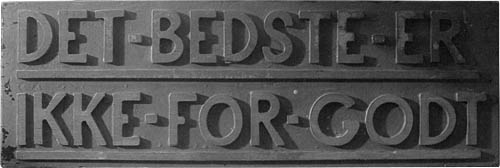LEGO
Godtfred began working with his father in 1932. He would attend school every other day and spent the rest of the time learning carpentry and the basics of the family business, such as bookkeeping. The business began to enjoy modest growth after the depression; by 1934 Ole had six or seven employees and 10 by 1939. The expanding catalog listed 49 different toys in 1936 and nearly 100 by the end of the decade.
With toys now his primary business, Ole realized that he needed a better name for his company, O. Kirk Christiansen, Trævare & Legetøjsfabrik
no longer seemed quite right, and in 1934 he held a naming contest among his employees.
His final choices were LEGIO (the Latin word for legion, as in legions of toys) and his own idea of LEGO; a contraction of the
Danish phrase “Leg Godt” (Play well).1
1. Lego also claims that the name means ‘I assemble’ or ‘I put together’ in Latin, but that appears to be a rather loose translation;
at least in English―Latin, perhaps it’s closer in Danish―Latin. Lego is now also an official English word and one of only two trademarked names in the
Oxford English Dictionary. The other being Xerox.
2. Kjeld stated in the early 2000’s: “By 2005, our goal is for the Lego brand to become the world’s strongest brand among families with children,”
and, depending on which studies you read, it has acheived at least some of this goal. In 2005 it was ranked the strongest brand among families in France and Germany, and the strongest brand among
boys in the US.
3. A more literal translation is “The best is not good enough.” Perhaps meaning that you can always do better. Whatever the translation, however, it still
is a pretty good motto.
He chose his own entry, won a bottle of homemade wine and, perhaps inadvertently, coined one of the
great brand names of the 20th century.2
Of course Ole did not immediately recognize the value of his new name, or the simplicity of a single name brand; starting around 1936 Ole stamped his toys with
LEGO Fabriken Billund, Fabrik for Trævare og Legetøg.
Ole had always insisted on quality work, both from himself and his employees; there was simply no other way to survive in such a small community. Godtfred immortalized this idea in a carved wooden plaque with the motto “Det bedste er ikke for godt” (Only the best is good enough),3 LEGO slowly built the business with a reputation for high quality.
In 1934, two years after the death of Kirstine, Ole married Sofie Jörgensen and they had a daughter, Ulla, in 1935. Events that were welcomed by the four brothers. As Godtfred recounts in 1982: “(Ole) was warmly supported by our new mother, who became a comforting force in our midst, making our house a home.”4 4. Hansen, Willy Horn. 50 Years of Play. Trans. Charles Napier. Billund: Lego System A/S, 1982.
The Yo-Yo Craze
Around this same time Ole had a brush with his first toy fad: the yo-yo. The yo-yo craze of the 1930’s is credited to Donald Duncan, a San Francisco businessman who created a huge demand in the US through an brilliantly conceived publicity campaign. Eager to repeat his success overseas he had expert demonstrators tour the concert halls of major European cities and the craze took off in Europe.
Naturally a wooden toy company like Lego was able to make as many yo-yos as anyone wanted. And they did, often working around the clock to meet demand. However, as fast as the craze took off it also collapsed. Soon the market was saturated and Ole was left with a considerable inventory that he could not sell. An inspiration struck: he split the yo-yos in half and used them as wheels for a car, which proved to be quite popular. A narrow escape perhaps, but one that taught Ole a lesson. He would never again chase toy crazes or fads; a strategy the company would successfully follow for several decades.
Godtfred’s Higher Education
Several of Ole’s sons were trained through the time-honored tradition of apprenticeship. Karl Georg trained as a carpenter and Gerhardt as a dairyman. Godtfred had quit school at 14 to work full time with his father. Later, he considered becoming a mechanic or engineer but he was such a talented designer that Ole convinced him to stay with the family business. In 1937, at the age of 17, he began creating models. Ole sent him to study drafting at a trade school in Haslev for a year. The year didn’t go well. His instructors thought toy designs were not the work of real draftsmen. Nevertheless he returned home with a number of toy designs, including one for a folding dollhouse. Ole was so impressed that he named him operations director. Godtfred had wanted to continue his studies in Germany, but the start of the war put an end to any further education.


